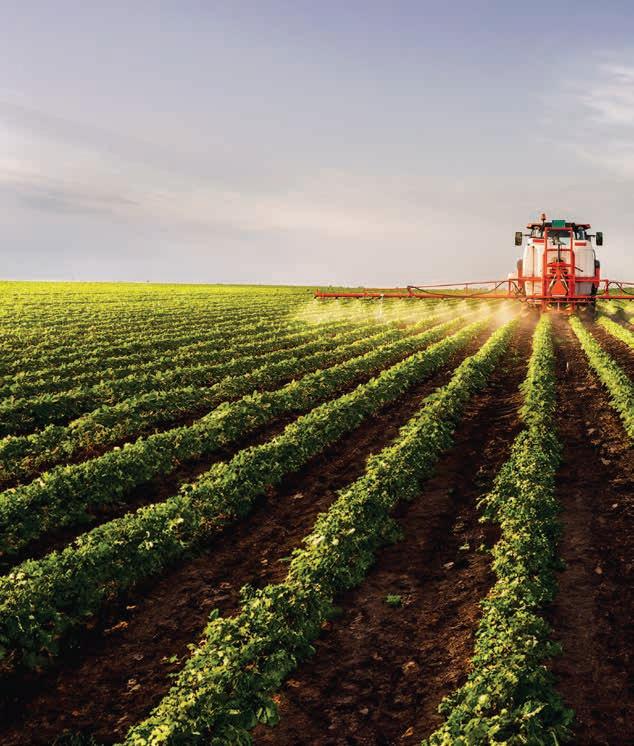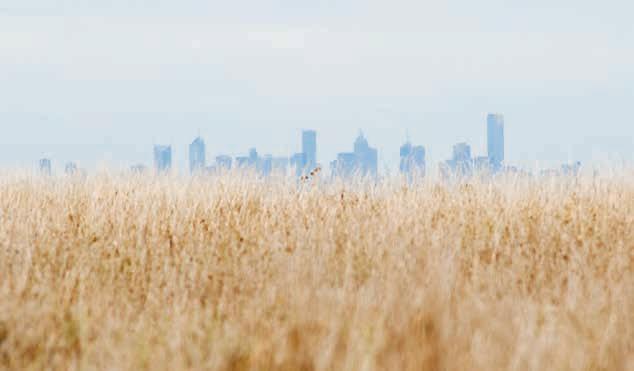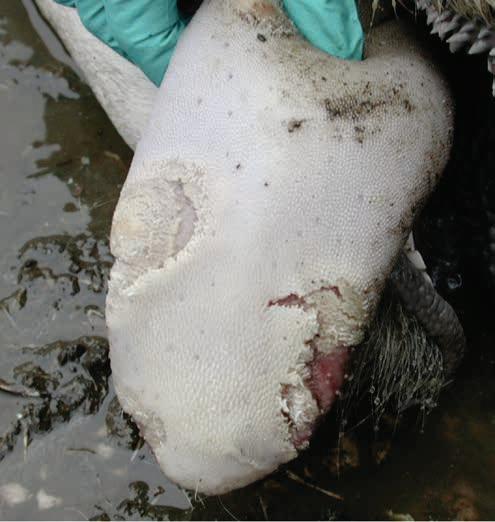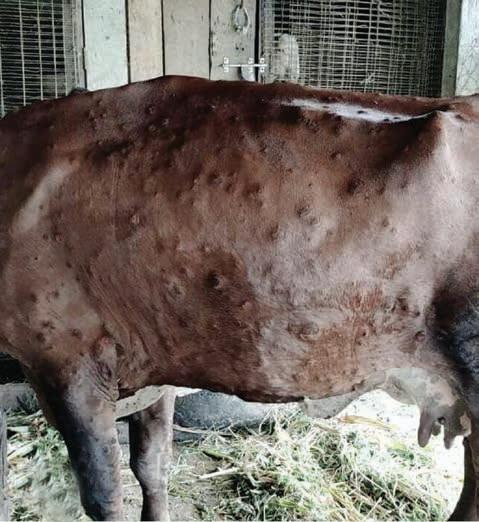
8 minute read
Safeguarding Australia's Agricultural Industry
Emergency disease response and national biosecurity measures.
At the WagyuEdge Conference in April 2023, Chris Parker, First Assistant, Animal Biosecurity in the Australian Government Department of Agriculture, Fisheries, and Forestry, delivered an enlightening presentation on emergency disease response in Australia. Focusing on Foot and Mouth Disease (FMD) and Lumpy Skin Disease (LSD), Chris emphasised the evolving nature of biosecurity threats and the importance of collective efforts in protecting Australia's agricultural industry.

Australia needs to have a well-developed biosecurity system to protect the agricultural industry from the risks of pests and diseases. In 2021-2022, Australian agricultural, fisheries and forestry exports reached an estimated record of $76 billion. Australia is currently free of many pests and diseases that affect animal production and welfare due to our geographical isolation, stringent biosecurity and quarantine procedures, national disease eradication and surveillance programs and strong partnerships between governments and the entire industry on animal health.
The Australian Government has recently released the national biosecurity strategy that provides a collective vision for Australia's future biosecurity and will help protect Australia's way of life. This strategy talks about being connected and resilient while sharing the responsibility for the nation's biosecurity.
Mr Parker explained how climate change, decreasing biodiversity, shifting trade and travel patterns, changing land uses, illegal activity, and major global disruptions and changing the Emergency Animal Disease (EAD) threats to Australia.
14 million to provide emergency funding for frontline biosecurity preparedness and support near neighbours

He went into detail about each of the threats we are facing.
Climate change is altering ecosystems, creating more favourable conditions for disease transmission. For instance, the spread of the blue tongue virus (BTV) has expanded due to the increased suitability of its insect vectors. As diseases are no longer confined to specific regions, Australia must be prepared to address new threats effectively.
Declining biodiversity affects ecosystem resilience, making them more susceptible to disease outbreaks. Practices like monocropping and large-scale cultivation reduce natural buffers against pests and diseases. Therefore, Australia requires greater vigilance and proactive measures to maintain high biosecurity levels.
Shifting trade and travel patterns. Increased international travel and trade pose many challenges in managing biosecurity risks. The surge in passenger numbers and changes in trade methods have created challenges at our borders. For example, shipping containers can be contaminated outside and inside. Ensuring the integrity of Australia's biosecurity system requires addressing these evolving trade and travel patterns.
Changing land uses. The increase in proximity between urban and rural areas heightens the need for enhanced biosecurity measures due to the potential threats to agricultural biosecurity. Foot and Mouth Disease (FMD) is an example where urban contaminants could lead to a significant outbreak if introduced to susceptible animals.

Illegal activity. Illicit imports of biosecurity-risk products, often driven by exotic markets, contribute to the spread of pests and diseases. These illegal activities undermine Australia's biosecurity system, which then requires increased monitoring and penalties to prevent the entry of high-risk items.
Major global disruptions , such as the COVID-19 pandemic, highlight the vulnerability of supply chains to biosecurity risks. For example, the import of a shipment of slate tiles from China brought an infestation of brown marmorated stink bugs that are exotic to Australia and are a huge environmental pest. Although the shipment came from a province and a port in China that Australia had never had an issue with before, the shipment was unloaded so the containers could be used elsewhere. The slates were left improperly stored for three months before reaching Australia, which allowed them to become contaminated—unforeseen infestations like this underscore the need for robust inspection and quarantine measures.
Increasing biosecurity risks overseas
The occurrence of pest and disease outbreaks, such as Lumpy Skin Disease (LSD) and Foot and Mouth Disease (FMD), has seen a notable rise overseas. These outbreaks present a significant risk to Australia, highlighting the importance of effective control measures and maintaining high biosecurity standards.

Mr Parker described the importance of knowing and understanding the clinical signs of FMD and LSD, as these diseases are a considerable risk to Australian trade. Their presence would be detrimental as we export 70% of our agricultural produce. If we were to have an outbreak of FMD, it would cost us more than $80 billion. Mr Parker said, "The market would shut overnight".
The clinical signs of FMD include:
drooling
fever
reluctance to move
blisters and ulcers
The potential introduction of FMD into Australia could have catastrophic consequences for the agricultural industry, as the country heavily relies on export markets for its livestock products.
Lumpy Skin Disease, caused by a virus of the poxvirus family, primarily affects cattle, and creates significant economic losses in the livestock industry.

The clinical signs of LSD include:
firm, raised nodules up to 50mm in diameter on the head, neck, genitals and limbs
scabs
swollen limbs, brisket, genitals
fever
watery eyes
decreased appetite
reluctance to move
pneumonia
Mr Parker highlighted Australia's collaborative efforts with the governments of Indonesia and neighbouring countries to address the biosecurity risks. Specifically, Indonesia has implemented a response strategy encompassing various measures to combat the spread of LSD and FMD. These measures include decontamination procedures, quarantine protocols, movement restrictions, vaccination programs, and vector control strategies. Additionally, zoning strategies are being implemented to effectively manage and contain the spread of the disease within specific areas. Such coordinated efforts between countries play a crucial role in mitigating the biosecurity risks and protecting the livestock industry from the impact of LSD and FMD.
$10 million biosecurity support package for Indonesia
$1.1 million to enhance biosecurity capacity in Indonesia's commercial feedlot sector
$11.7 million to expand our detector dog capability at the boarder
Australia is actively assisting Indonesia in strengthening its biosecurity response capabilities. This support includes technical advice, provision of FMD and LSD vaccines, necessary supplies, education and communication, staff training, funding, and emergency field missions. Collaborative efforts with neighbouring countries are essential for effectively managing and containing disease outbreaks. Australia is also committed to bolstering the preparedness of neighbouring countries for FMD and LSD. Australia aims to build a more resilient regional biosecurity network by sharing knowledge, resources, and best practices.
Australia's Biosecurity Plan
Australia's biosecurity plan involves a comprehensive and multifaceted approach to safeguarding the nation's borders and agriculture.
The establishment of the Emergency Animal Disease Preparedness (EADP) Joint Task Force showcases the government's commitment to proactive measures, and the Senate inquiry further reinforces the emphasis on continuous improvement and preparedness.
Effective communication through platforms such as social media channels is vital in raising awareness of disease control, and collaboration with industry partners ensures a coordinated response and optimal resource allocation.
Regarding import control, Australia has imposed bans on certain products while expanding screening efforts at airports and mail centres—increased vigilance across flights, supported by communication campaigns, aids in the early detection of biosecurity risks. Deploying detector dogs and foot mats at airports contributes to enhanced border protection.
Regular review of import permits ensures stringent compliance with biosecurity standards. Establishing biosecurity response zones further strengthens the country's ability to contain and manage potential outbreaks effectively.
National LSD Action Plan
The implementation of the National LSD Action Plan and research into vaccine options are key priorities that will help to bolster readiness. The National LSD Action Plan demonstrates a collaborative effort between the Australian government and industry representatives, aiming to effectively address the challenges posed by Lumpy Skin Disease (LSD).
International engagement is emphasised, fostering collaboration with global partners to exchange knowledge, best practices, and research findings. Diagnostic capability is strengthened to ensure rapid and accurate detection of LSD cases, facilitating prompt response and containment, and well-developed surveillance systems are implemented to monitor and track the spread of the disease.
Awareness and communication efforts are integral to informing the industry and the public about LSD, its risks, and preventive measures. Finally, the National LSD Action Plan addresses recovery measures, focusing on supporting affected farmers and restoring agricultural operations following the unlikely case of an LSD outbreak.
By covering these factors, the plan provides a comprehensive framework to tackle LSD and minimise its impact on Australia's livestock industry.
What can you do for Australia’s biosecurity?
Farmers and those involved in the agricultural industry play an important role in ensuring national biosecurity, as it is a shared responsibility. Producers must remain alert without being alarmed and take proactive measures to protect their properties. One crucial step is to create a comprehensive biosecurity plan for their farms.
Visit farmbiosecurity.com.au for valuable resources and guidance in developing an effective biosecurity plan. Testing and refining the plan is essential to ensure its effectiveness.
Farmers should be aware of who is entering their property and what is being brought onto it. This biosecurity strategy not only safeguards against specific threats like FMD and LSD but also other endemic diseases. It is essential to familiarise yourself with the clinical signs of emergency animal diseases like FMD and LSD, as signs consistent with these diseases must be reported to the Emergency Animal Disease (EAD) Watch Hotline on 1800 675 888 or your local veterinarian.





